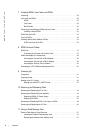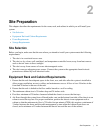The E600i System | 11
3
The E600i System
The Dell Force10 E600i system is a carrier-class, high-capacity aggregation router. The 9-slot modular
system provides 2 slots dedicated for route processor modules (RPMs) and 7 slots to accommodate line
cards with Layer 2 and Layer 3 switching and routing capabilities.
Operating Overview
The E600i system requires an RPM, at least one line card, and at least four switch fabric modules (SFMs)
for packet processing. The RPM is the core for routing and control operations. All traffic destined to the
E600i terminates on the RPM. Routing table entries are built on the RPM and directed to the forwarding
information tables on the line cards.
RPM software processes, such as Telnet, SNMP, Layer 2, and Layer 3 functions, are divided among three
CPUs for redundancy and speed. Independent software images run on each CPU. Each CPU has its own
memory, which isolates processes from each other, increasing reliability. Operating the E600i system
with two RPMs enables automatic fail-over redundancy.
Line cards perform all data forwarding operations. Each line card has Dell Force10 proprietary ASICs;
the flexible packet classification (FPC) ASIC and the Buffer and Traffic Manager (BTM) ASIC. The FPC
accepts packets, feeds packets to input/output ports, handles packet classification (access lists, Layer 2
and Layer 3 lookups) and packet marking (Diffserv or 802.1p). The BTM is responsible for all queuing
operations.
The internal flash memory device shipped with the RPM contains the boot ROM and runtime images.
Each RPM accommodates an external flash memory card that can be used to copy and store system boot,
software images, and configuration files. For information about using a flash card, refer to
Chapter 11,
Using a Flash Memory Card
.


















